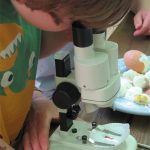A slightly different version of this post appeared first in our late summer 2014 issue of Chip Notes.
 As you may recall, we “took advantage” of the devastating flood, integrated that with several pre-existing hopes and plans, and coordinated an initiative we call Bridges to Birds. This four-fold project will make (and already is making) the Museum more accessible to all, indoors and out, enabling better and more bird conservation, environmental education, and appreciation of Vermont’s natural communities.
As you may recall, we “took advantage” of the devastating flood, integrated that with several pre-existing hopes and plans, and coordinated an initiative we call Bridges to Birds. This four-fold project will make (and already is making) the Museum more accessible to all, indoors and out, enabling better and more bird conservation, environmental education, and appreciation of Vermont’s natural communities.
One phase of the Bridges to Birds Project, Connecting to New Perspectives (the Treehouse), was completed this summer, and you can read more about it elsewhere in the blog.
Two other phases, Connecting to Nature (with Interpretative Trails) and Connecting to Conservation (with Bird-friendly Gardens) are actively underway, thanks primarily to several dedicated volunteers and interns.
Now we focus our attention on another phase: Connecting to People (the reconstruction of our parking-to-entrance access). This one is perhaps the largest endeavor, and you’ve probably seen and read about the planning, engineering, and design aspects already in previous issues of Chip Notes.
Early in August we heard the great news that in the next few weeks the town of Huntington will replace the culvert that funnels the water from the creek above the Museum, under Sherman Hollow Road, and down to “Bob’s Bridge.” This is an essential prerequisite to our own construction process. Once this culvert and Sherman Hollow Road have been repaired, the Museum can start the physical repairs to create a safe passage for visitors from the parking lot to the Museum doors.
While waiting for this construction to start, we all have been learning and researching ADA laws, erosion prevention techniques, effective interpretation methods, and the ways entrances can shape and enhance Museum-going experiences. We have also been consulting with designers and engineers, writing grants, and working on other fundraising to bring this phase into reality.
So Far, with Gratitude
We are grateful for the support already given for work to date:
- FEMA helped fund some of the emergency work last year: clearing downed trees and debris; removing electric lines ($800)
- Vermont Community Foundation’s Special and Urgent Needs grant helped support initial personnel time (staff and consultant) as we began the planning and design of both temporary and permanent measures to bring people safely to the Museum, and storm water through the property ($5000).
- Museum members and community donors help pay for some of the additional staff time as we continue to plan, apply for new grants, and develop related presentations and literature. Some of these donations will go directly to the initial construction costs ($7000).
We also recently received a grant from the Vermont Better Back Roads program to address stormwater runoff, preventing damage in the future. If you have seen the photos of the parking lot, or stopped in recently, you know from your own experience how essential this is to protect the riparian habitats along the tributary creek and Sherman Hollow Brook.
The Next Steps
We are about to embark on a fundraising campaign for the bulk of entrance-access construction. These costs are great. There will be costs for detailed plans and oversight from structural and civil engineers, the site work, bank stabilization, stream bed restoration, the ADA-compliant bridge and walkway construction, materials, and interpretation. One member has already promised to match all donations!
As space here is limited, look for another mailing with more information about the entire project. It will include detailed goals for each phase, costs, donation information, and a generous list of thank you gifts, from watercolor prints by Libby Davidson, to a very special one donated by Denver Holt, renowned Snowy Owl biologist.
Thank you to all who have donated so far! We will continue to post pictures as progress is made. This is a very exciting time as we not only repair what was damaged but create a fully welcoming space that connects people to the essential and exciting world of birds.
You can help
Make a financial donation
We happily accept donations online through JustGive, NetworkForGood, and PayPal. Or use the phone or address below.
Membership
Renew yours, become a new member, or give a gift membership to a bird-loving friend or family member. Use our online membership form (PDF).
Volunteer with us
Opportunities abound! Our Volunteer page has more info.
Bird Conservation Choices
Use your everyday choices, from the coffee you choose to the laws you enact, to create a world better for birds.
You can also call (802) 434-2167 with your credit card info, or send a check in any amount at any time to
Birds of Vermont Museum900 Sherman Hollow Road
Huntington, Vermont 05462











